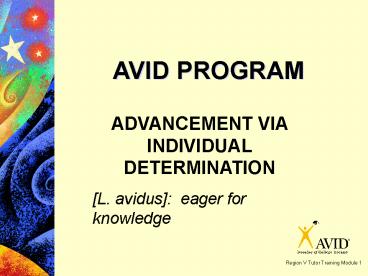AVID PROGRAM - PowerPoint PPT Presentation
1 / 15
Title:
AVID PROGRAM
Description:
Motivational Activities. WICR Strategies ... Speakers. Motivational. A. c. t. i. v. i. t. i. e. s *(within block) T. u. e. s. d. a. y. Monday. W. e ... – PowerPoint PPT presentation
Number of Views:42
Avg rating:3.0/5.0
Title: AVID PROGRAM
1
AVID PROGRAM
ADVANCEMENT VIA INDIVIDUAL DETERMINATION
L. avidus eager for knowledge
2
AVID Mission
- AVID is designed to increase schoolwide learning
and performance. The mission of AVID is to ensure
that ALL students, and most especially the least
served students who are in the middle - will succeed in rigorous curriculum
- will complete a rigorous college prep path,
- will enter mainstream activities of the school,
- will increase their enrollment in four-year
colleges, and - will become educated and responsible participants
and leaders in a democratic society.
3
Achieving Mission
- Elective Program
- Writing-based curriculum
- Study Skills and Test Prep
- College and Career Exploration
- Tutorial Support
- Motivational Activities
- WICR Strategies Methodologies
4
WRITING Prewrite Draft Respond Revise Edit Final
Draft Class Textbook Notes Learning
Logs/Journals
INQUIRY Skilled Questioning Socratic
Seminars Quickwrites/Discussions Critical
Thinking Activities Writing Questions Open-Mindedn
ess Activities
W I C R
COLLABORATION Group Projects Study Groups Jigsaw
Activities Read-Arounds Response/Edit/Revision
Groups Collaborative Activities
READING SQ3R (Survey, Question, Read, Recite,
Review) KWL (what I Know, Want to learn,
Learned) Reciprocal Teaching Think-Alouds
5
(No Transcript)
6
Goal of AVID Tutorial
- Teach students skills needed to work
collaboratively to solve problems (WICR) - Empower students to answer own questions by
posing questions which help them think more
deeply about what they are learning (WICR)
- Guide students in high-level discussions of
critical topics as a means of developing
vocabulary, enhancing discussion skills
fostering thought processes which enable them to
succeed in rigorous courses (WICR) - Reinforce writing skills through review of
Cornell Notes, learning logs, quick writes, etc.
(WICR)
7
AVID Tutorial Structure
- Completed Tutorial Request Form
- Collaborative Learning
- Reflection
8
Inquiry Based Tutoring Learning
- Tutors never give or show the answer
- Tutors ask questions that lead students to learn
how to find the answers - Students learn to ask questions that cause them
to think at deeper levels - Blooms 6 levels
- Costas 3 levels
9
Source of Student Questions
- Homework
- Notes from lecture, textbook, video, etc.
- Test preparation
- Test results
- Reading
- Other assignments
10
History of Cornell Notes
- Developed in 1949 at Cornell University by Walter
Pauk - Designed in response to frustration over student
test scores - Adopted by most major law schools as the
preferred note taking method
11
WHY CORNELL NOTES?
- Designed as a learning tool, not a recording tool
- Act as a study aide, not an abbreviated list of
information - Results from AVID data collection show student
reference to Cornell Notes as key to academic
success
12
Improving Writing
- Learning Logs
- Quick Writes
- Collaborative Pre-writes
- Peer Editing
- Clusters
- Essay Structure
- Graphic Organizers
13
Improving Reading
- Time to Read / Pre-read
- SQRQCQ
- Textbook Treasure Hunt
- Think Alouds
- Mark It Up
- Reading Logs
- Reading Diaries
14
Effective Collaborative Groups
- Individual accountability
- Heterogeneous groups
- Shared leadership
- Shared responsibility
- Social Skills for task completion
- Tutor facilitation, support, intervention
15
Collaborative Group Strategies
- Jigsaws
- Read-Arounds
- Write-Arounds
- Pair Share
- Gallery Walks
- Using White Boards































